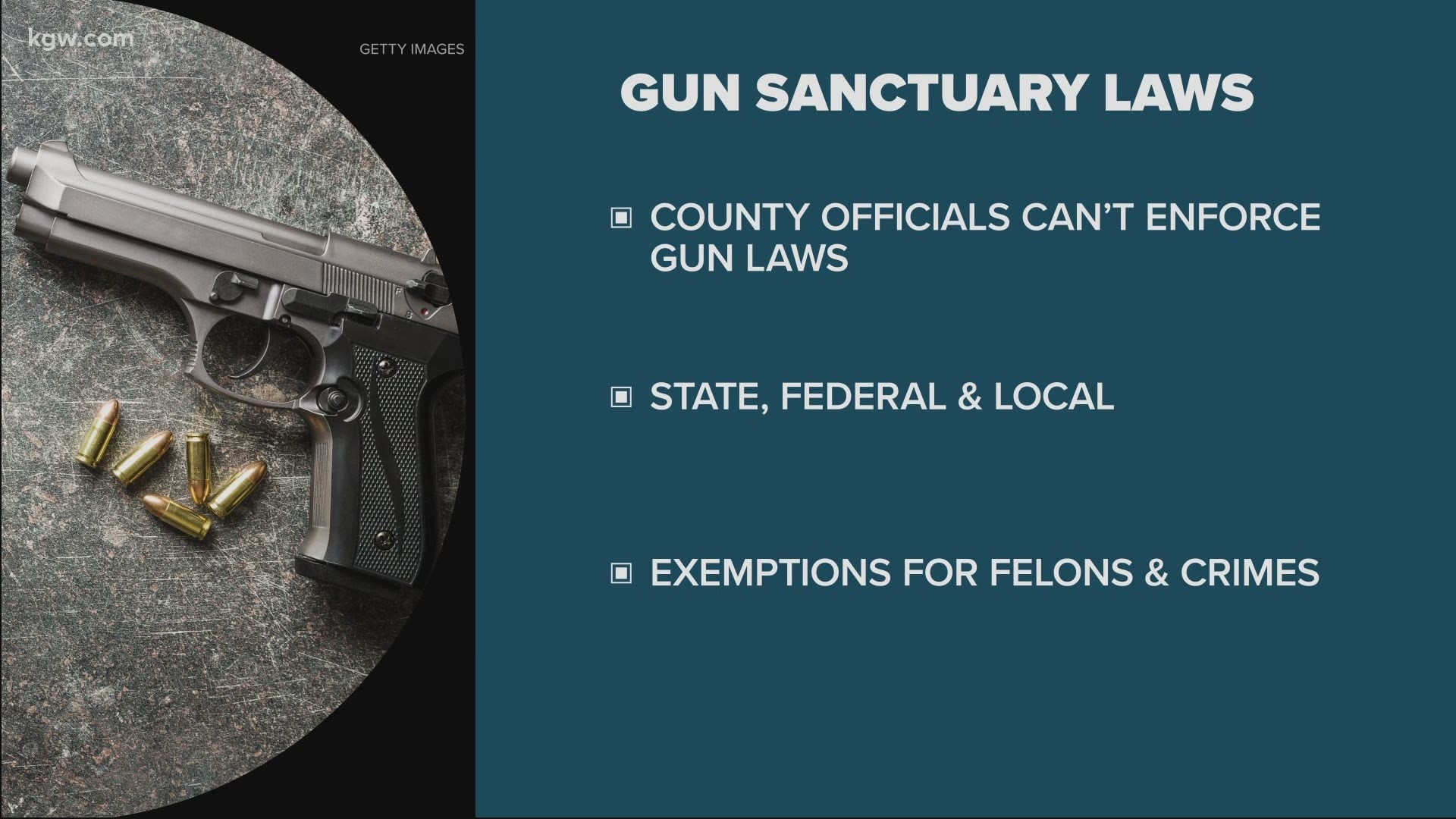PORTLAND, Ore — On the November ballot, several Oregon counties saw measures to prevent enforcement of firearm regulations. Columbia and Umatilla counties passed the Second Amendment sanctuary ordinances, or “SASOs,” while Coos and Clatsop counties rejected them.
These ordinances are intended to prevent county officials from enforcing most state, federal and local firearm regulations, like background checks, firearm registration or tracking and laws regarding open or concealed carry, among others.
The ordinances could face legal challenges due to potential conflicts with state and federal law.
Unofficial results show 62% of Umatilla County voters supported the SASO. A similar ordinance narrowly passed in Columbia County, 50.78% to 49.22%.
Clatsop County rejected the measure by 61 to 38.84%, but the race was closer in Coos County, where 54.3% voted against the measure and 45.19% supported it.
In both Columbia and Umatilla counties, the ordinances could prevent county officials from “devoting resources or participating in any way in the enforcement of any law or regulation that affected an individual’s right to keep and bear arms, firearm accessories, or ammunition,” according to election office documents.
In Columbia County’s voters guide, the Oregon Firearm Federation wrote, “All ballot measure 5-278 does is ensure your right and ability to defend your life and the lives of your loved ones.”
In Columbia and Umatilla counties, individuals who violate the ordinance could be subject to a $2,000 fine, and “corporations” would be subject to a $4,000 fine. Exemptions would be made for enforcing firearm regulations on convicted felons or prosecuting crimes involving firearms.
What inspired these Second Amendment sanctuary ordinances?
The term “Second Amendment Sanctuary” is based on the idea of “sanctuary cities”, which flourished in the 2000s as liberal cities tried to resist immigration policies.
Several Oregon counties — Columbia and Umatilla included — previously passed “Second Amendment Preservation Ordinances” or “SAPOs.” These sought to protect residents’ right to keep and bear arms but did not explicitly penalize those that violate this right.
Penny Okamoto, executive director of Ceasefire Oregon, said that the sanctuary ordinances give the SAPOs more “teeth” to enforce the measure by fining those who violate the ordinance.
Oregonians, affiliated with the Oregon Firearm Federation, aim to pass SASOs in every county in the state, according to their website.
Tyler Smith, an attorney affiliated with the SASOs, said the measures are inspired by “a desire to have local control for local jurisdictions, to be able to be in charge of what firearm regulations, ammunition regulations, and magazine capacity regulations local police officers enforce or do not enforce.”
Supporters also justify the ordinances as a means of fighting back against Salem lawmakers looking to enact more gun regulations and protesters hoping to defund the police.
Okamoto said the ordinances were also, in part, a reaction to the Oregon Firearm Safety Act (SB 941), which requires background checks for almost all gun sales.
Are these ordinances legal?
Experts say that the SASO ordinances may conflict with a state statute, ORS 166.170, which explicitly gives the Oregon Legislature authority to regulate firearms in the state. It also voids any “county, city or other municipal” ordinance that seeks to regulate or restrict firearms and ammunition.
The ordinances may also conflict with the U.S. Constitution Supremacy Clause, which says county and state laws cannot supersede federal law.
Smith said that the ordinances do not violate these laws because they address enforcement of firearm regulations, rather than creating or removing new laws or regulations.
Still, Okamoto said that SASO supporters are setting themselves up for lawsuits, with county employees torn between local and state law.
“These employees are really caught between a rock and a hard place,” Okamoto said. “Either they violate these SASOs or they violate Oregon law and maybe even federal law.”
The sheriffs of Columbia and Umatilla counties have not yet responded to request for comment.
Both county ordinances will likely go through validation hearings to determine their legality.
“I think it would be helpful to verify that (the ordinance) is valid,” Doug Olsen, county counsel of Umatilla County, said.
Auxier said that, as district attorney, it is his duty to be responsive to the values of the voters in Columbia County.
“My community has spoken,” he said. “They stand strong in support for gun rights. And I intend to honor that support for gun rights within the bounds of the law as much as I can.”
But Auxier said that he also must prioritize public safety.
According to data from the Oregon State Police Firearms Instant Check System (FICS), compiled by Ceasefire Oregon Education Foundation, state firearm background checks increased by 49% from 2019 to 2020 (Jan. 1 to Sept. 30).
In Columbia County, those background checks rose by 88%, and Ceasefire Oregon is worried that the sanctuary ordinance could result in more gun-related crimes, deaths and accidents.
“I intend to do what I can to protect the community and save lives,” Auxier said. “Theoretically, those two things (saving lives and protecting gun rights) could come into conflict — I’ll take that as it comes.”
The timeline of the validation hearings for the ordinances in Umatilla and Columbia counties has yet to be determined.


